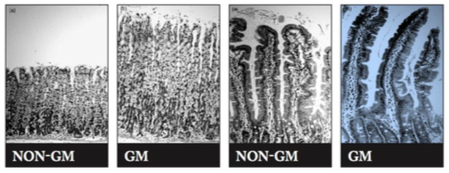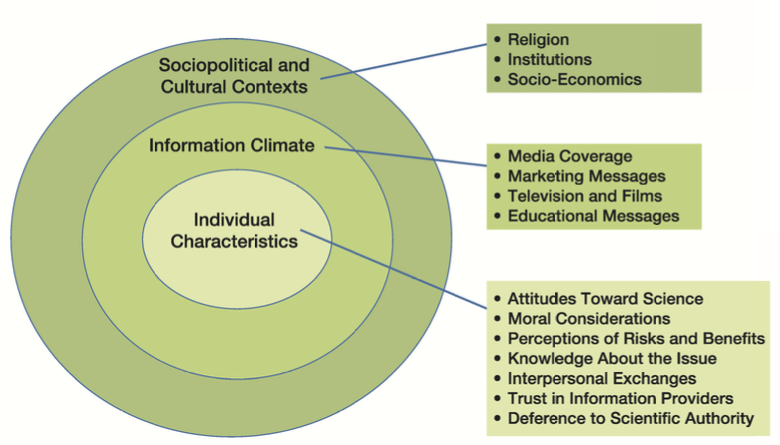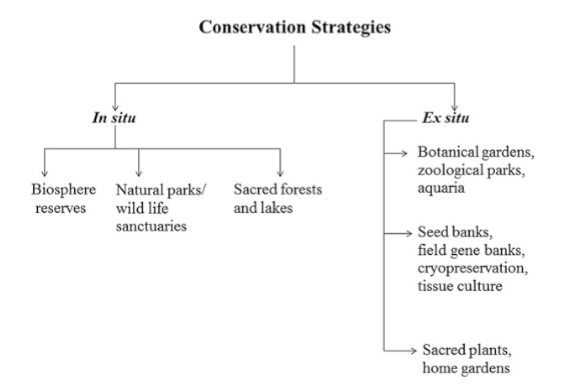GMOs: Do They Help the Sustainability of Food Systems?
Note/disclaimer: This webpage is for instructional purposes only and the scenario described below is fictional.
This page was developed as a hypothetical report detailing GMOs written on behalf of The Food and Agriculture Organization.
UW-Madison Task Force Members:Shelby Brendler, Department of Agronomy and Conservation Biology
Samuel Danton, Department of Dairy Science
Olivia Paszkowski, Department of Biology and Psychology
Scenario | Abstract | Introduction | Methods | Economic | Social | Environmental | Limitations | Conclusion | Citations | Acknowledgements | About the Authors
Scenario
The Food and Agriculture Organization (FAO) of the United Nations recently announced that they will be holding a convention to further discuss the use of genetically modified organisms (GMOs) in various countries in May of 2019. Overall, the debate regarding the use of GMOs is well known to the FAO, and as a result, they want to acknowledge both sides of the debate during the convention. Additionally, the FAO wants details on the sustainability aspects that are associated with the implementation of GMOs. To get this information, the FAO has approached three students, Sam, Shelby, and Olivia, with this research opportunity. They have asked Sam, Shelby, and Olivia to determine whether the use of genetically modified organisms emphasizes sustainability in food systems.
Abstract
Genetically modified organisms (GMOs) refer to organisms that have been genetically altered from their original state in order to improve specific characteristics (World Health Organization 2014). GMOs have been at the forefront of many discussions over the past few decades, and yet the controversy has still not been resolved. This paper aims to provide the ideas and viewpoints from each side of the debate, and analyze the science that supports or revokes these ideas. Furthermore, this paper aims to define the aspects of sustainability that genetically modified organisms fulfill, which includes economic, environmental, and social components. Upon further analysis, it was concluded that while both the pro- and anti-GMO perspectives have valid points regarding the implementation of GMOs, whether or not the costs outweigh the benefits is still undetermined. More research is required to fully understand every feature of genetically modified organisms, and to conclude whether their use and application is overall beneficial.
Introduction
| By definition, GMO refers to an organism that has been altered via the insertion of one or more transgenes, which can be detailed in the video below. It is likely that any new GMO varieties will fall into one of four crop types (soybean, maize, cotton, and canola), and that the improved traits will primarily be versions of herbicide tolerance and insect resistance (Ruane, 2013). In general, the most agricultural genetic diversity can be found in the tropical zones of the world: however, most technologies that have the ability to create more precise adaptations of genotypes to environmental conditions, nutritional needs, and market preferences are held by developed countries, especially the United States (FAO, 2001). |
|---|
Initially, genetically modified organisms were introduced in the United States when the Flavr Savr tomato appeared on market shelves in 1994. Then, in 1996, herbicide-resistant soybeans were introduced to allow farmers to apply herbicides on the plants without harming the crop itself. GMOs can be modified in a variety of ways, and these modifications are classified as generations. A first generation trait adds tolerance such as herbicides or environmental considerations. Application of a second generation trait would add value such as nutritional aspects, and third generation traits would provide additional qualities that go beyond traditional foods. Overall, the majority of crops found within the United States are first generation crops, although there has been approval of some second-generation crops. Commonly, in the United States we see three GMO crops grown which includes cotton, soybeans, and corn (Wunderlich, 2015).
After the introduction of GMOs, numerous concerns related to food safety, the environment, and economic issues arise. Often, the health and food concern pertain to the possible toxicity or allergenicity of the produced GMOs. In regard to the environmental concerns they center around the introgression of those transgenes into the natural landscape, impact of gene flow, and the loss of biodiversity. Lastly, the economic issues reference to the loss of income for resource-poor farmers (Atici, 2014).
Methods
Using electronic databases, multiple articles were found based on preset factors. Factors include time range, key words, and relevance to the topic in question. The time range focused primarily on the period from 1980 to 2018. Key terms used included “genetically modified organisms”, “genetic engineering”, “health risks”, “environment”, “international policies” and “biodiversity”. These series of articles denoted the background of GMOs and their impact in regards to the three pillars of sustainability. From that point, scientific and non-scientific articles were included to identify the varying viewpoints on GMOs at a international, local, and individual level. The articles acknowledging myths were taken into consideration if they provided justifications of the claims from reliable sources. We determined a source to be reliable if the authors had conducted their own research on the given topic and if additional articles were referenced. Each article that fit these criteria were then used in their relevant section within the paper.
Economic
 |
| Figure 1: Fraction of plots in comparison to the yield in kilograms per hectacre in Bt hybrid, Non-Bt counterpart, and popular check. Source: Qaim and Zilberman (2003). |
Atici (2014) examined the production, trade, and regulation controversy that accompanies GM crops on a global scale. In addition, the impact of low level presence (LLP) and adventitious presence (AP) of crops on the overall trade flow was investigated. To analyze all these aspects, the FAO distributed a survey that covered general information touching on the production, safety assessment, LLP and AP incidents, along with many other specific points. Within these surveys, it was highlighted that nearly half of the countries that were surveyed produced GM crops for either commercial or research purposes. To obtain results, a bilateral trade flow model and cross sectional data was used to determine that the implementation of strict regulation have negative effects on maize trade. The survey also showed that incidents involving LLP and AP tend to end in the rejection or the market withdrawal of developing countries. Impacts due to LLP on trade flow are often insignificant in ad hoc model, and theoretical estimation yielded a negative impact marginally. According to Atici (2014), the countries that produce GM crops should take precautions in the production, harvesting, transportation, storage, and marketing stages to eliminate the LLP in conventional crops. To completely understand the impacts or regulations, one must use the standards of a holistic approach with covers the risks associated with GM crops along with the trade effects. Overall, GMOs seem to have a positive effect on an economical scale.
Social
 |
| Figure 2: The influence of GMO potatoes on the stomach lining (left) of a rat and the influence of GMO potatoes on the intestines (right) of a rat. Source: Smith (2017). |
Consumer health is a main area of interest in regards to the social pillar of sustainability. Smith (2017) worked to prove that GMOs are harmful to consumers. To test this stance, 3,256 participants participated for nine months in which they were asked to report their current health status while consuming GMOs, and provided the same survey after they stopped the consumption of GMOs. It was seen that there was damage to the immune system, reproductive system, vital organs, digestive system, and endocrine system. In general, results pointed towards an improvement in health after the reduction in GMO consumption. In contrast, Gupta and Singh (2017) deemed GMOs would allow for a potential nutrient implications for the consumer with foods being created to be more nutrient dense.
Much of the research on consumer health is limited as GMOs are relatively new, there has not been a sufficient amount of time to conduct thorough large-scale health studies. Of the research that has been published, most studies focus on the immediate, short-term health effects of GMOs on small, localized populations. Additionally, there are serious moral and ethical implications of testing the effects of these organisms on humans, which has resulted in many studies using animal subjects instead. However, these results are not always generalizable or applicable to humans, as De Vendômois, Cellier, Vélot, Clair, Mesnage, and Séralini (2010) examined and retested data from toxicological tests done on rats by Monsanto on three of their genetically engineered crops. Previously, Monsanto conducted three different 90-day rat feeding studies in order to determine if any of the GMOs created or contributed to any chronic toxicity or health effects in mammals. While Monsanto’s results supported their claim that their genetically modified organisms did not negatively affect mammalian health, the results of the authors’ independent testing showed that there were statistically significant effects of feeding rats GMO crops. This study also examined the statistical and experimental methodologies of the Monsanto feeding trials and found them to be lacking in consistency, generalizability, and accuracy of interpretation. The authors conclude by insisting on mandatory testing of genetically modified organisms and standardized testing and analysis procedures.
 |
| Figure 3: Diagram of the aspects that contribute to how consumers think about GMOs. Source: Rhodes and Sawyer (2015). |
Consumer knowledge of genetically modified organisms is another emerging issue. As demonstrated by Marris (2001), public myths about GMOs are unsubstantiated using the Public Acceptance of Agricultural Biotechnologies (PABE). To understand the the acceptability of GMOs, Marris notes that it is necessary to break down the myths into its components and determine the influence they have on behavior. By applying the PABE, it identifies that consumers still have concerns about GMOs even if they do not oppose GMOs. It was also determined that a consumer’s perception about GMOs is molded by their previous experience with similar issues. These perceptions can also help explain why public opinion plays a significant role in the development and marketing of GMOs in Europe.
Furthermore, Rhodes and Sawyer (2015) wrote a detailed summary of the National Research Council’s Roundtable on Public Interfaces of the Life Sciences two-day workshop in Washington D.C. The major focuses were on the way that people think about GMOs, the scientific presentation, the cultural and political context of GMOs, and how scientists should engage in the debate about GMOs. The way people think about GMOs pointed towards various myths that many individuals believe along with the reasonings behind them. In the process of detailing the reasoning behind myths, representatives presented their own studies that tested the corresponding myths. The cultural and political context accumulates an argument that these two aspects play a large role in an individuals view on GMOs. This highlights the importance of disseminating scientific knowledge, research, and findings to consumers in a format that is easily understood and believed.
Environmental
 |
| Figure 4: The crop loss in comparison to the insecticide used. Source: Qaim and Zilberman (2003). |
One of the main questions surrounding genetically modified organisms is how they affect the environment. Current research shows that overall, GMOs contribute positively to the environment. As detailed in a study done by Qaim and Zilberman (2003), genetically modified crops reduce the amount of pesticides and fertilizers applied to fields because they generally are more resistant to and resilient when faced with diseases, pests, and inclement weather, allowing inputs to be used more efficiently. Similar findings were supported by Singh(2017) as the researchers explore the roles of environmental biotechnology (i.e. biofertilizers, biopesticides) in the future of sustainability. Some of the possible applications of genetically modified organisms detailed by the author include use in genetic characterization and genomic conservation, crop disease research and prevention, and in improving nutrition. This in turn reduces the potential for nutrient runoff, surface water eutrophication and pollution, and chemical residues among other things, since fewer inputs need to be applied. Additionally, reducing the number of chemical applications reduces the number of times machinery is driven on fields, which reduces soil compaction and increases soil stability, resulting in less soil erosion and better planting conditions. Such information was found by Qaim and Zilberman (2003) as there field study determined the nutrients in the soil no longer went to waste with dying crops, and there was a significant reduction in hazardous chemicals.
 |
| Figure 5: The breakdown of the conservation approach by the strategies that can be applied. Source: Adenle (2012). |
Less environmental pollution has positive implications for the conservation and protection of biodiversity. Adenle (2012) sheds light on the endangerment of biodiversity due to a combination of factors which includes climate change, spread of invasive alien species, pollution, uncontrolled urbanization, land-use change, and unsustainable agriculture and forestry practices. A loss in biodiversity can lead to an increase in poverty, food security and undermine sustainable development. Given the rate of biodiversity loss by the year 2012, there is an urgent demand for technological innovations to help and overcome the loss. Additionally, Adenle details a conservation approach which can be effective with the implementation of building capacity, finance and technological innovation paired with environmental policies being put in place, specifically in developing countries.The main difficulty is getting the various governments and intergovernmental organizations to pursue a common goal. Because of this, there is an international urgency to intervene to enhance both conservation and development. However, the possibility of genetic drift from genetically engineered crops and the cross-contamination of wild and organic species is a growing area of concern as it could have devastating effects on the diversity of wild-type genomes and the integrity of organic crops.
Limitations
There is a lack in case studies in other countries, specifically Europe. This lack in global perspective can primarily be due to the governmental regulations set forth by each country, and the overall acceptance of GMOs on a global scale.
A vast amount of short-term research was found, yet no longitudinal studies about the effects of GMOs were present. Without the consideration of long-term effects, there is inconclusive results on the overall effects of GMOs.
Also, there is not much research done on GMOs with consideration to their presence in the media. Rhodes and Sawyer (2015) acknowledged when looking at the scientific presentation, there is an emphasis on the framing of scientific information, the media involving GMOs, and the way they can negatively impact public opinion of GMOs. The presentation of the information pertaining to such a touchy topic as GMOs has a significant effect on it’s acceptance and research.
The current paper focused in on mainly the GMOs implemented in crop farming, although GMOs now extend to fisheries and other food systems. Beardmore and Porter (2003) detailed the process of genetic modification in animals versus plants. They found that genetically modified organisms in aquaculture have much to offer in terms of improvements in production, food security, and generating economic benefits. Although the researchers noted that the risks associated with GMOs need to be analyzed and quantified in more realistic and reliable ways than they are being done currently. This article highlights the benefits that can be associated with GMOs in other food systems along with the uncertainty of the risks that may be associated with their implementation.
Conclusion
The creation and implementation of genetically modified organisms in agriculture has been one of the most significant technological events in recent history. As such, GMOs have seen their fair share of controversy, most of which has centered around three major themes: economics, the environment, and social implications. Though there are many concerns about the implications of GMOs on these three areas, the vast majority of research points to genetically modified organisms having positive impacts. Economically, GMOs can increase crop yields while decreasing additional agricultural inputs, which increases profits and decreases costs for farmers. In terms of environment impacts, the reduced need for fertilizers and pesticides decreases the risk of pollution and chemical runoff, as well as having positive effects on soil health and overall crop productivity. The social implications of genetically modified organisms are nuanced, as prior opinions about other biotechnologies can highly impact a consumer’s opinion of GMOs. How GMOs affect consumer health is another rapidly evolving area of research, with different studies finding dramatically different results.
There is significant potential for genetically modified organisms in the future of agriculture. They can be used to improve human nutrition in the developing world, decrease natural resource use, contribute to the intensification of production agriculture, and boost international markets and trade. However, before this potential can be fully realized, most researchers and studies agree that more research needs to be done in all three areas of interest because genetically modified organisms have only been introduced in the past few decades. Additionally, this research needs to be done on both a global and local scale, as well as on human subjects rather than other mammals. The need for long-term studies is also emphasized, as this is the only way to discover chronic health implications.
Citations
Adenle, A A. 2012. Failure to achieve 2010 biodiversity’s target in developing countries: How can conservation help? Biodiversity Conservation, 21: 2435-2442.
Atici, C. 2014. Low Levels of Genetically Modified Crops in International Food and Feed Trade: FAO International Survey and Economic Analysis. Food and Agriculture Organization of the United Nations Commodity and Trade Policy Research Working Paper, 44.
Beardmore, J. A. & Porter, J. S. 2003. Genetically Modified Organisms and Aquaculture. FAO Fisheries Circular. No. 989. Retrieved from http://www.fao.org/3/Y4955E/y4955e00.htm#Contents.
De Vendômois, J.S., Cellier, D., Vélot, C., Clair, E., Mesnage, R., & Séralini, G.E. 2010. Debate on GMOs Health Risks after Statistical Findings in Regulatory Tests. International Journal of Biological Sciences,6(6): 590-598.
Food and Agriculture Organization of the United Nations. 2001. Genetically modified organisms, consumers, food safety and the environment. Retrieved from http://www.fao.org/3/x9602e/x9602e01.htm#TopOfPage.
Gupta, R. & Singh, R. 2017. Genetically Modified Organisms (GMOs) and Environment. Principles and Applications of Environmental Biotechnology for a Sustainable Future, Applied Environmental Science and Engineering for a Sustainable Future. DOI 10.1007/978-981-10-1866-4_14
Marris, C. 2001. Public views on GMOs: deconstructing the myths. European Molecular Biology Organization Reports, 2(7): 545-548.
Qaim, M. & Zilberman, D. 2003. Yield Effects of Genetically Modified Crops in Developing Countries. Science, 2, 900-902.
Rhodes, H. & Sawyer, K. 2015. Public Engagement on Genetically Modified Organisms When Science and Citizens Connect Workshop Summary. National Academy of Sciences, 1-47.
Ruane, J. (2013). An FAO e-mail conference on GMOs in the pipeline in developing countries: The moderator’s summary. Retrieved from http://www.fao.org/docrep/017/ap998e/ap998e.pdf
Singh, R.L. 2017. Introduction to Environmental Biotechnology. Principles and Applications of Environmental Biotechnology for a Sustainable Future, Applied Environmental Science and Engineering for a Sustainable Future. DOI 10.1007/978-981-10-1866-4_1
Smith, J. 2017. Survey Reports Improved Health After Avoiding Genetically Modified Foods. International Journal of Human Nutrition and Functional Medicine.
World Health Organization. 2014. Frequently asked questions on genetically modified foods. Retrieved from https://www.who.int/foodsafety/areas_work/foodtechnology/faq-genetically-modified-food/en/
Acknowledgements
This project would not have been successful without the contributions of the outstanding students in our Food Systems, Sustainability, and Climate Change class. We would particularly like to acknowledge the wonderful and challenging questions, and the specific knowledge that students with different areas of expertise provided.
About the Authors
 | Shelby Brendler has majors in agronomy and conservation biology, as well as a certificate in environmental studies. A junior at the University of Wisconsin-Madison, she hope to work for the United States Department of Agriculture as a sustainable agriculture and natural resources consultant. |
|---|
 | Samuel Danton is a junior studying dairy science, with a certificate in global health, at the University of Wisconsin-Madison. After receiving his bachelor's degree, he hopes to work for an NGO or cooperative focusing on sustainable agriculture in dairy or developing countries. |
|---|
| |
|---|
 | Olivia Paszkowski is a biology and psychology major at the University of Wisconsin-Madison. After she receives her undergraduate degree, she plans to get her master’s in bacteriology and hopefully attend medical school. |
|---|
